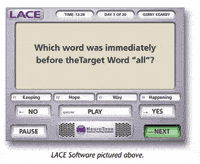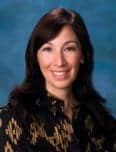We’ve all seen the television ads. A hard-bodied, tan, oily Adonis and Diana, each with 6-pack “abs” and more muscles in their shoulders than most of us have in our entire bodies, are working out on a contraption that looks like the result of an insane engineer’s mating of a crossbow with a medieval torture device. As these bumpy muscled athletes flex and strain against the machine, a voice-over keeps repeating the catch-phrase: “30 minutes a day, five days a week to a better body.” Although it’s unlikely you will be handing out body oil and tanning booth tickets to your patients any time soon, your future may include the phrase “30 minutes a day, five days a week, for four weeks to better hearing” if a new aural rehabilitation tool called Listening and Communication Enhancement (LACE) becomes a fixture in dispensing offices.
LACE is the creation of Robert Sweetow, PhD, and Jennifer Henderson-Sabes, MA, at UCSF, as well as software engineers Gerry Kearby, Earl Levine, and Rob Modeste at NeuroTone Inc, Redwood City, Calif. This article examines the new, interactive tool which is designed to provide listening retraining via a patient’s home computer (and soon a hard-wire interface to the television) as a supplement to their in-office aural rehabilitation (AR) program.
AR is What We Do
It should come as no surprise to dispensing professionals that, in general, as the one-on-one counseling time between the professional and the patient increases, the greater the likelihood there is for meaningful increases in customer satisfaction. Kochkin1 demonstrated in MarkeTrak VI that the amount of counseling time, as well as post-purchase surveys, are positively correlated with improvements in customer satisfaction. Consumers receiving no counseling time have customer satisfaction ratings of about 40%, while those receiving two hours or more have ratings of about 60% (eg, on the “high side” of the average customer satisfaction ratings of 63% in 2000).
Perhaps more than the actual hearing instrument fitting, technology, or comfort issues, it is counseling and aural rehabilitation that are the prime elements of customer satisfaction. Indeed, it has been put forth by Weinstein1 that the one crucial feature that elevates audiology above being a specialized field of “laboratory science” for medicine is the necessity of aural rehabilitation and the dispensing of hearing instruments. Aural rehabilitation requires that the dispensing professional becomes an independent case manager. And this, in turn, means that providing exemplary counseling services for the patient is a prerequisite of any quality hearing health care program.
However, there are at least four problems in providing “ideal” hearing care services to the typically diverse population of patients served by hearing care professionals: 1) once an individual leaves your office with his/her hearing aids, you are no longer there to counsel them on a daily basis; 2) the progress they make (eg, outside the dispensing office and/or a group AR program) can largely be defined as “self-rehabilitation” because patients develop (or don’t develop) their own adaptation skills to cope with challenging listening situations—even with the most diligent audiological help, they must adjust to their hearing instruments “on the fly” in a wide range of settings; 3) up until now, there have been no programs available that help people make use of those parts of speech they can access only with difficulty (eg, fragmented speech either with or without a hearing aid); 4) many people who have suffered with hearing loss for an extended period of time (eg, 5-10 years) lack confidence in their communication skills and may need positive reinforcement to stay on the path to better hearing.
Hearing is Not Necessarily Listening
What is LACE? LACE is an interactive computerized training program designed for home use. Its purpose is to train the brain to utilize and develop skills that can ultimately diminish the communication deficiencies associated with hearing loss (aided and even unaided). Just as physical therapy can help rebuild muscles and adjust movements to compensate for physical weakness or injury, LACE is designed to develop skills and strategies that can help compensate for those situations when hearing is inadequate.
What is the purpose of the system? We don’t hear with our ears; we hear with our brain. Hearing instruments can help a person detect softer sounds that were previously inaudible to them, but they don’t necessarily provide good listening skills or “retrain the brain” to access information presented within the newly audible information.
Good listening skills are one of the components essential for effective communication. Other components include rapid thought processing, auditory memory, use of language skills, and interactive strategies. In addition, confidence that what you thought you heard was in reality what was spoken, is vital. Spontaneity of expression and unexpected statements make life interesting; they are the essence of humor and intellectual exploration. However, the ability to discern what was said can be deteriorated both by hearing loss and by the natural aging process. LACE is designed to enhance the ability to communicate by training the brain to better utilize these skills. Thus, the objectives of LACE are:
- To get the patient involved.
- Make the patient recognize the difference between hearing and listening.
- Build patient confidence.
- Provide the patient with communication strategies.
- Lower return-for-credit rates.
- Reduce unnecessary patient visits.
How It Works
LACE provides a variety of interactive and adaptive tasks for the patient that are divided into three main categories: degraded speech, cognitive skills, and communication strategies:
Degraded speech. For degraded speech exercises, LACE presents either time-compressed speech to simulate a person who talks fast, or it presents speech with background babble noise or a single competing talker (including that of a male, female, and child). The patient listens to and identifies the signal, then sees the correct response on the screen. If the message is correctly interpreted, the next sentence is then presented at a slightly more difficult level; if the message is misinterpreted, the next sentence is presented at an easier level. In other words, the difficulty level of the task is based on the accuracy of the patient’s response to the previous task.
Cognitive skills. The system provides stimulating training exercises to enhance auditory memory and speed of processing—two elements of listening that are particularly important in noisy environments. These exercises take the form of a missing word in a sentence that is “filled in” by the patient, or asks the person about words preceding or following a “target word” in the sentence (eg, see the question on the screen in Figure 1).

Communication strategies. LACE also presents and demonstrates strategies that help people who are hard of hearing cope in their daily communication activities. These include tips on asking where to be seated in a noisy restaurant, advice on telephone use, and communication tips for the patients and their friends and loved ones.
Patients are asked to work through the program, which ideally takes 30 minutes per day, five days per week, for four weeks to complete (10 hours total), but is specifically set up to let the patient progress at his/her own pace. Besides the immediate feedback given for each task, LACE provides the patient and dispensing professional with a graph (Figure 2) depicting daily improvement and progress from the start of the training program. This is also designed to encourage the patient and to give them a boost in confidence. It also reasserts the value of their choice in obtaining amplification (in the case of a hearing aid purchase).

FIGURE 2. A graphic representation of progress is made available to the patient, showing them how they are performing in the various training exercises.
The results of the training are tracked by the software, and the data can be electronically transmitted to a HIPAA-compliant secure Web site which is accessible by the hearing care provider. In this way, the patient’s progress can be monitored, and individualized recommendations can be made as he/she uses the program. Additionally, any need for subsequent modifications in the training can be implemented.
Practical Aspects
The objective of LACE is to enhance the listening and auditory communication skills of those individuals with or without amplification. A recent pilot study involving the system strongly suggests that listening skills can be enhanced with practice and immediate feedback.3 Although this study involved a small number of subjects, those using the system generally showed improvements in speech-in-noise and the other training-related tasks.
The LACE software is currently available on a CD disk. However, future versions of the program will feature a hardware interface that plugs directly into a television set. In the future, it may become available on a portable device for patients who don’t own computers.
A five-minute video that portrays the video from an audiologist’s perspective is available and more information on the system can be obtained at the NeuroTone Web site (www.neurotone.com).
| Information and much of the text for this article was submitted by Robert W. Sweetow, PhD, director of Audiology and professor of Otolaryngology the University of California at San Francisco. LACE is a product of NeuroTone™ Auditory Training Solutions, 2317 Redwood City, CA 94063; Web site: www.neurotone.com. Correspondence can be addressed to HR or Robert W. Sweetow, PhD, University of California, San Francisco, 400 Parnassus Ave, A 705, San Francisco, CA 94143-0340; email: [email protected]. |
References
1. Kochkin S. Factors impacting consumer choice of dispenser & hearing aid brand; Use of ALDs and computers. The Hearing Review. 2002;9(12):14-23.
2. Weinstein B. Geriatric Audiology. New York: Thieme Medical Publishers; 2000.
3. Sweetow RW, Henderson-Sabes J. The case for LACE: Listening and auditory communication enhancement training. Hear Jour. 2004;57(3):32-40.





